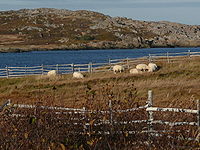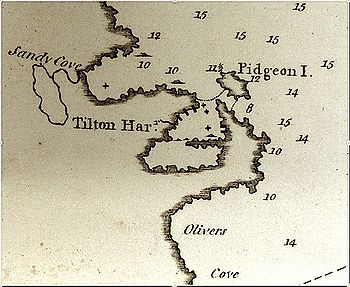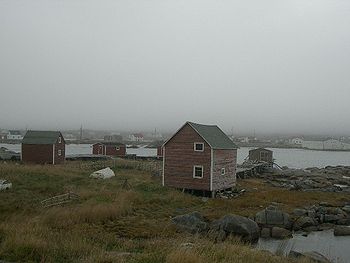
Tilting, Newfoundland and Labrador
Encyclopedia

Tilting is a town on the eastern end of Fogo Island off the northeast coast of Newfoundland. The community has been designated as a National Cultural Landscape District of Canada
Canada
Canada is a North American country consisting of ten provinces and three territories. Located in the northern part of the continent, it extends from the Atlantic Ocean in the east to the Pacific Ocean in the west, and northward into the Arctic Ocean...
in 2005 by Parks Canada
Parks Canada
Parks Canada , also known as the Parks Canada Agency , is an agency of the Government of Canada mandated to protect and present nationally significant natural and cultural heritage, and foster public understanding, appreciation, and enjoyment in ways that ensure their ecological and commemorative...
, and was also designated as a Registered Heritage District by the Heritage Foundation of Newfoundland and Labrador
Heritage Foundation of Newfoundland and Labrador
The Heritage Foundation of Newfoundland and Labrador is a non-profit organization which was established by the Provincial Government of Newfoundland and Labrador in 1984 to stimulate an understanding of and an appreciation for the architectural heritage of the province...
.
Tilting is noted for the large number of traditional Newfoundland fishing structures and houses, many of which have been restored in recent years. The town is noteworthy for the longevity of its Irish culture and dialect. The town was first settled in the mid-18th century.
History
Tilting is one of the most historically significant settlements in Eastern CanadaEastern Canada
Eastern Canada is generally considered to be the region of Canada east of Manitoba, consisting of the following provinces:* New Brunswick* Newfoundland and Labrador* Nova Scotia* Ontario* Prince Edward Island* Quebec...
.
Though Tilting was located on the "French Shore
French Shore
The French Treaty Shore resulted from the 1713 ratification of the Treaty of Utrecht. The provisions of the treaty allowed the French to fish in season along the north coast of Newfoundland between Cape Bonavista and Point Riche. This area had been frequented by fishermen from Brittany since the...
" area of Newfoundland, and was likely visited by French
French people
The French are a nation that share a common French culture and speak the French language as a mother tongue. Historically, the French population are descended from peoples of Celtic, Latin and Germanic origin, and are today a mixture of several ethnic groups...
fishing crews in the 17th century, there is no evidence that the French ever settled in Tilting. The style of fishery practiced by the French did not require them to have permanent bases on land, but they did use temporary shore stations to process fish. The French also spent time on shore in order to collect wood and water, to wait out storms, and to repair their fishing craft. Beginning around the 1720s, English
English people
The English are a nation and ethnic group native to England, who speak English. The English identity is of early mediaeval origin, when they were known in Old English as the Anglecynn. England is now a country of the United Kingdom, and the majority of English people in England are British Citizens...
migratory fishing crews began to probe northward from Trinity
Trinity, Newfoundland and Labrador
Trinity is a small town located on Trinity Bay in Newfoundland and Labrador.The harbour at Trinity was first used by fishing ships around the 16th century. The Portuguese explorer Gaspar Corte-Real is said to have named this place because he arrived here on Trinity Sunday in 1501. It was settled by...
and Bonavista
Bonavista, Newfoundland and Labrador
Bonavista is a town on the Bonavista Peninsula, Newfoundland in the Canadian province of Newfoundland and Labrador. Unlike many Newfoundland coastal settlements, Bonavista was built on an open plain, not in a steep cove, and thus had room to expand to its current area of 31.5 square...
, and it is at this time that the first settlers probably over-wintered at places like Tilting and neighbouring Joe Batt's Arm. By the 1780s, Tilting evolved into an exclusively Irish
Irish people
The Irish people are an ethnic group who originate in Ireland, an island in northwestern Europe. Ireland has been populated for around 9,000 years , with the Irish people's earliest ancestors recorded having legends of being descended from groups such as the Nemedians, Fomorians, Fir Bolg, Tuatha...
enclave, beginning with the first visitors from Ireland
Ireland
Ireland is an island to the northwest of continental Europe. It is the third-largest island in Europe and the twentieth-largest island on Earth...
around 1752, and continuing with the arrival of other Irish planters through the end of the 18th century.
In 1767, Notre Dame Bay
Notre Dame Bay
Notre Dame Bay is a large bay in Newfoundland, Canada. To the south it adjoins the Bay of Exploits.The name, French for Our Lady Bay, dates to at least 1550, and is possibly a French translation of an earlier Portuguese name....
was surveyed by Michael Lane, who had been working with the famous Captain James Cook
James Cook
Captain James Cook, FRS, RN was a British explorer, navigator and cartographer who ultimately rose to the rank of captain in the Royal Navy...
, until Cook was recalled to England
England
England is a country that is part of the United Kingdom. It shares land borders with Scotland to the north and Wales to the west; the Irish Sea is to the north west, the Celtic Sea to the south west, with the North Sea to the east and the English Channel to the south separating it from continental...
. Lane's map clearly shows that Tilting was a substantial and important fishing station and settlement by the 1760s.

Twillingate
Twillingate is a town of 2,448 people located on the Twillingate Islands in Notre Dame Bay. It is located off the northeastern shore of the island of Newfoundland in the province of Newfoundland and Labrador. It was incorporated on September 30, 1965. The town is about north of Lewisporte and...
, which was initially named "Toulinguet" by the French. For a while, colonial officials in St. John's
St. John's, Newfoundland and Labrador
St. John's is the capital and largest city in Newfoundland and Labrador, and is the oldest English-founded city in North America. It is located on the eastern tip of the Avalon Peninsula on the island of Newfoundland. With a population of 192,326 as of July 1, 2010, the St...
mistakenly referred to Tilting as "Tilton Harbor" in some official documents. By the early 20th century, it was known as "Tilting Harbour" again.
The first settlers in Tilting were probably English bye-boat fishermen and planters; many of the prominent landmarks in Tilting have English names, such as Henning's Hill, Dominey's Brook, Chalk's Hill, and Trugard's. Eventually the Irish focused their settlement on Tilting, and the English moved away. This may have been because the large merchant in the area, Lester's of Trinity, placed an Irish agent named Ryan at Tilting, to serve the Irish and manage their accounts with Lester. Thomas Burke was probably the first Irish planter to settle in Tilting, apparently in 1752. He had a substantial fishing business based out of Tilting and carried his fish and seals directly to St. John's rather than selling them to merchants on Fogo Island. Burke was a strong Catholic
Catholic
The word catholic comes from the Greek phrase , meaning "on the whole," "according to the whole" or "in general", and is a combination of the Greek words meaning "about" and meaning "whole"...
and allowed Mass
Mass (liturgy)
"Mass" is one of the names by which the sacrament of the Eucharist is called in the Roman Catholic Church: others are "Eucharist", the "Lord's Supper", the "Breaking of Bread", the "Eucharistic assembly ", the "memorial of the Lord's Passion and Resurrection", the "Holy Sacrifice", the "Holy and...
to be said in his large stage, when this was technically forbidden by British officials. At the time, the Catholic faith was outlawed in England and its colonies, but travelling Irish priests occasionally visited outports like Tilting.
Other early Irish settlers at Tilting were men named Foley, Dwyer, McGrath, Broders, Mahoney, Lane, Reardon, Keefe, Sexton, and Greene. These names all still survive today among the residents of Tilting.
The oldest house in Tilting, the Lane House, is currently used as a museum. It may have been built in the late 18th century.
Another very old house is known as "Ryan's House" and may have belonged to Lester's agent Ryan (see above.) It is located on the Keefe premises.
The Irish Cemetery in Tilting may be the oldest existing exclusively Irish cemetery in North America
North America
North America is a continent wholly within the Northern Hemisphere and almost wholly within the Western Hemisphere. It is also considered a northern subcontinent of the Americas...
.
Tilting has an outstanding collection of original and restored Irish Newfoundland houses, stages, and other outbuildings. There are also traditional early-modern complexes of gardens outside and throughout the town, as well as traditional root cellars, slide paths, and wells. This substantial and rare collection of traditional structures and material culture contributed to Tilting's being designated a Registered Heritage District in 2003 (see below.)
Tilting's population was 393 in 1940 and 401 in 1956.
Tilting Registered Heritage District
In 2003 Tilting was designated a Registered Heritage District by the Heritage Foundation of Newfoundland and LabradorHeritage Foundation of Newfoundland and Labrador
The Heritage Foundation of Newfoundland and Labrador is a non-profit organization which was established by the Provincial Government of Newfoundland and Labrador in 1984 to stimulate an understanding of and an appreciation for the architectural heritage of the province...
. It was the first time the Foundation recognized an entire community for its significance to Newfoundland and Labrador's heritage. The citation reads as follows:
Tilting Originally founded by the French in the 17th century as a base for their transatlantic fishery, Tilting became a station for the English and Irish migratory fishery sometime after 1713. Permanent settlement followed in the 1720s and by the 1770s it had become a predominantly Irish community, shortly evolving into an exclusively Irish preserve. The cultural milieu in which those early Irish thrived is evidenced today both in the material culture and vibrant oral traditions for which Tilting is so well known. Tilting is one of the few rural Newfoundland communities where the full range of the buildings associated with the traditional family-based, inshore fishery can still be experienced.

Tilting Cultural Landscape District
On August 27, 2005, Tilting was designated a National Cultural Landscape District by the Historic Sites and Monuments Board of Canada. The citation reads as follows:Tilting Cultural Landscape Irish settlers began to shape this landscape from about the 1730s, building houses and fishing rooms around the harbour to support the inshore fishery. Influenced by the inheritance customs of their homeland, Tilting's residents subdivided the original land lots, developing clusters of extended family neighbourhoods. They also adapted the Irish tradition of keeping gardens, with those near home more intensively cultivated and those farther away used mainly for hay or crops for winter storage. Like other Newfoundlanders, they enclosed their fields with wooden fences and pastured livestock on the open commons. Many of Tilting's landscape components, including the harbour, the extensive gardens near Sandy Cove and Oliver's Cove, and the summer and winter paths, are used in much the same way today as in the past. While continuing to evolve, this community retains an unusually complete range of vernacular building types, and the arrangements and interrelationships of traditional buildings and spaces have largely been maintained. Still inhabited by descendants of its early families, Tilting survives as a rare example of a once common Irish-Newfoundland cultural landscape. (Historic Sites and Monuments Board of Canada, August 27, 2005.)
Further reading
- Robert Mellin, Tilting: House Launching, Slide Hauling, Potato Trenching, and other Tales from a Newfoundland Fishing Village. Princeton Architectural Press; 2003.
- John Carrick Greene, Of Fish and Family: Family Histories and Family Trees of Tilting, Set Against a Background of Historical Developments In The Newfoundland Fisheries, 1700 - 1940. Triumphant Explorations Ltd.; 2003.
- Mannion, John, et al. "The Newfoundland Fishery, 18th Century," Plate 25 in The Historical Atlas of Canada, Volume I. R. Cole Harris, ed., University of Toronto Press; 1987.
- Handcock, Gordon, et al. "Trinity, 18th Century," Plate 26 in The Historical Atlas of Canada, Volume I. R. Cole Harris, ed., University of Toronto Press; 1987.
- Dwyer, Allan. "A Different Kind of Newfoundland: Planter Success in 18th Century Notre Dame Bay," The Newfoundland Quarterly, Vol 99, No. 2, 2006, pp. 38–45.
- Anonymous, Historic Sites and Monuments Board of Canada: Ceremony Commemorating the Tilting Cultural Landscape District (Program Booklet), Tilting, Fogo Island, Newfoundland and Labrador (Ottawa: Parks Canada, August 27, 2005).
External links
See also
- Fishing stageFishing stageA fishing stage is a wooden vernacular building, typical of the rough traditional buildings associated with the cod fishery in Newfoundland, Canada. Stages are located at the water's edge or "landwash", and consist of an elevated platform on the shore with working tables and sheds at which fish...
- List of cities and towns in Newfoundland and Labrador

